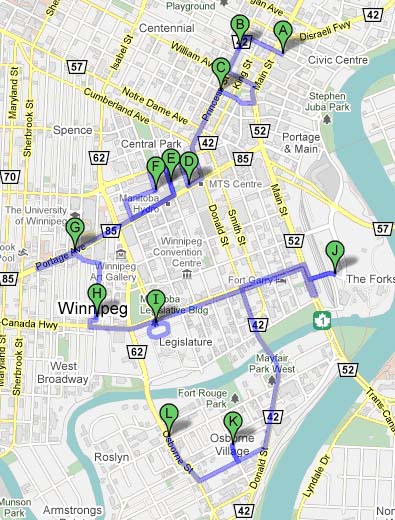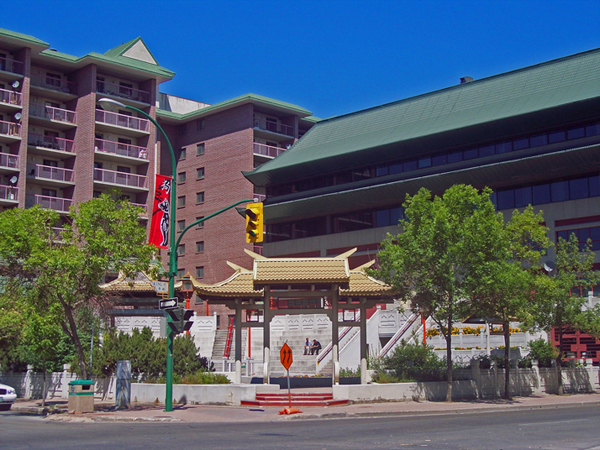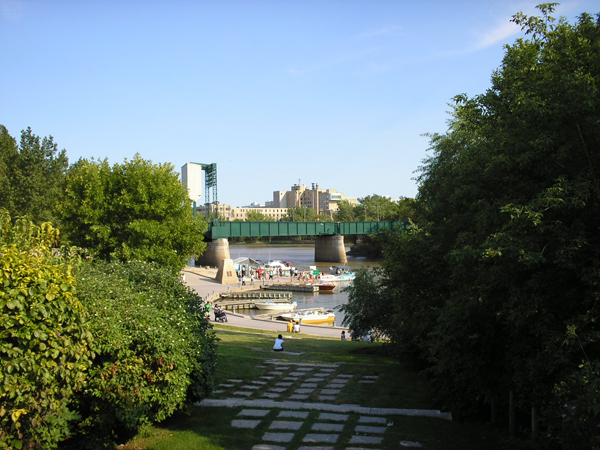The Travels of a Journalistâ€â€ÂÂ66- After Winnipeg, we learn: penny-wise, pound-foolish
Posted on April 14th, 2011
By Shelton A. Gunaratne ƒÆ’-¡ƒ”š‚©2011 Professor of mass communications emeritus at Minnesota State University Moorhead
When we left our home in Moorhead, Minn., 17 July 1989, on my summer internship and family holiday trip to the Pacific Northwest, we hoped to return to our own cozy ƒÆ’‚¢ƒ¢-¡‚¬ƒ…-castleƒÆ’‚¢ƒ¢-¡‚¬ƒ”š‚ to unwind and relax after our tedious 10-day camping trip through the Trans-Canada Highway 1 on 4 Sept. 1989.ƒÆ’-¡ƒ”š‚
When we left home on this two and one-half month excursion, we kept our Moorhead home under lock and key. During my 10-year teaching stint in Rockhampton, Australia, we were wont to shut off power and other utilities when we left our Queensland-style home on stilts during long breaks. We expected to accrue substantial savings by applying the Oz practice to our new habitat in the Village Green area of Moorhead.
On our return home about 9 p.m. Monday (4 Sept.), we learnt the hard way that the application of the Oz practice to our Minnesota home was one of the ƒÆ’‚¢ƒ¢-¡‚¬ƒ…-dumbestƒÆ’‚¢ƒ¢-¡‚¬ƒ”š‚ things we had ever done.ƒÆ’-¡ƒ”š‚ Our savings on utilities turned out to be peanuts compared to the losses we incurred by so doing.
To our surprise and dismay, we found our basement flooded with approximately 5 centimeters of water. Because we had shut off electricity, the sump pump hardwired to our homeƒÆ’‚¢ƒ¢-¡‚¬ƒ¢-¾‚¢s electrical system had ceased to operate. (Homes with basements use this device to pump out water accumulated in a water collecting sump pit.) The intrusion of water rendered the basement carpeting unusable and spoilt the collection of books and journals stacked in the bottom shelf of a couple of bookcases. Thus, we learned the wisdom expressed in the idiom ƒÆ’‚¢ƒ¢-¡‚¬ƒ…-penny-wise, pound-foolish.ƒÆ’‚¢ƒ¢-¡‚¬ƒ”š‚
Background
Considering that we didnƒÆ’‚¢ƒ¢-¡‚¬ƒ¢-¾‚¢t arrive at our campsite, east of Portage la Prairie, until after 1 a.m. Monday, we slept until late morning because we decided to take it easy on the final day of our travels. It was about 11 a.m. when we left our overnight campsite.
Back on Trans-Canada 1, as we crossed the meandering Assiniboine River a couple of times on our way to Winnipeg, we realized that we have been driving on the drainage basin of the 1,070 km Assiniboine from eastern Saskatchewan onwards.
The Assiniboine forks with the 885 km Red River of the North at ƒÆ’‚¢ƒ¢-¡‚¬ƒ…-The ForksƒÆ’‚¢ƒ¢-¡‚¬ƒ”š‚ park in downtown Winnipeg, the capital and the most populous city of the province of Manitoba. The Red, which originates at the confluence of the Bois de Sioux and Otter Tail rivers in the United States, flows awkwardly from south to north through the flood-prone Red River ValleyƒÆ’‚¢ƒ¢-¡‚¬ƒ¢¢”š¬‚encompassing the metropolitan areas of Fargo-Moorhead and Grand ForksƒÆ’‚¢ƒ¢-¡‚¬ƒ¢¢”š¬‚and empties itself into Lake Winnipeg in Manitoba that spews out into Hudson Bay.ƒÆ’-¡ƒ”š‚
Manitoba has a population of 1.2 million with almost 60 percent concentrated in the metropolitan Winnipeg area. The majority in the province, almost 55 percent, claims to be of British originƒÆ’‚¢ƒ¢-¡‚¬ƒ¢¢”š¬‚English, 22.9 percent; Scottish, 18.5 percent; and Irish, 13.4 percent. Remarkably, 19.1 percent of Manitobans claim German ethnicity while 14.7 percent claim Ukrainian ethnicity. Almost 20 percent of these groups identify themselves to be Canadian as well.
Doings in Winnipeg
As we drove into the western outskirts of Winnipeg on Trans-Canada 1, the first tourist attraction we passed was GrantƒÆ’‚¢ƒ¢-¡‚¬ƒ¢-¾‚¢s Old Mill (2777 Portage Ave.). Cuthbert Grant, leader of the MƒÆ’†’ƒ”š‚©tis at the Battle of Seven Oaks, established the first watermill of the Red River settlement on this site in 1829.ƒÆ’-¡ƒ”š‚ The museum offers tours of the site to demonstrate how the early settlers used millstones to grind grain into flour.
Going further east, we stopped at the 445-hectare Assiniboine Park (established 1904), which includes the 283-hectare Assiniboine Forest to the south, Assiniboine Zoo, Assiniboine Conservatory, Assiniboine Park Pavilion, formal and informal gardens, a sculpture garden, a miniature railway, an outdoor band shell theatre for performing arts, and several other attractions. The Canadian predilection for British fads are again evident in this mammoth park, where English landscape style is applied to 36 percent of its total area. Carmel, 5, and Junius, 9, found this vast parkland an ideal place to test their levels of energy. All of us thoroughly enjoyed the English Garden ƒÆ’‚¢ƒ¢-¡‚¬ƒ…-for its luxuriant display of thousands of annual and perennial flowersƒÆ’‚¢ƒ¢-¡‚¬ƒ”š‚ (Wikipedia).
Assiniboine Park brought to my mind memories of Stanley Park in Vancouver, B.C. (see Travels-61). Again, we had no illusions of visiting all the attractions that Winnipeg offered. We had to pick and choose a few that interested us within the limited time we spent in the city. We opted to visit the following:
Figure 1: Sites I visited in downtown Winnipeg 1989=1990ƒÆ’-¡ƒ”š‚ ƒÆ’-¡ƒ”š‚ ƒÆ’-¡ƒ”š‚ ƒÆ’-¡ƒ”š‚ ƒÆ’-¡ƒ”š‚ ƒÆ’-¡ƒ”š‚ ƒÆ’-¡ƒ”š‚ ƒÆ’-¡ƒ”š‚ ƒÆ’-¡ƒ”š‚
A=Manitoba Museum of Man (190 Rupert Ave.); B=Chinatown; C=Spaghetti FactoryƒÆ’-¡ƒ”š‚ (291 Bannatyne Ave.); D=Times Bar (301 Hargrave St.); E=Winnipeg Free Press (300 Carlton St.); F=Promenade-on-the-Arc Motor Hotel (defunct); G=Canadian Broadcasting Corporation (541 Portage Ave.) H=Downtown Winnipeg; I=Legislative Building/ Government House complex; J=The Forks Park/Market at intersection of Assiniboine and Red rivers; K=McKim Communications Ltd.; L=Yuk YukƒÆ’‚¢ƒ¢-¡‚¬ƒ¢-¾‚¢s comedy club (moved out)ƒÆ’-¡ƒ”š‚
Winnipeg Chinatown (pop 20,000). Because of her Chinese ethnicity, my wife Yoke-Sim insisted on visiting Chinatown located on King Street between James and Higgins avenues. The pioneer Chinese established the site in 1908 but they failed to get official recognition until 1968. Pacific Avenue is the old heart of Chinatown with the most historic buildings. The Kingstown strip mall stands at the intersection of King Street and Henry Avenue. We ate a lavish lunch at the Kum Koon Garden (257 King St.) restaurant. Yoke-Sim splurged all the Canada currency she had on purchasing Chinese groceries to take home.
Chinese Cultural Centre in Chinatown, Winnipeg (20 July 2006).ƒÆ’-¡ƒ”š‚
Source: Wikimedia Commons. Photo by Cayla]
Manitoba Legislative Building (450 Broadway).ƒÆ’-¡ƒ”š‚ We joined the 3.30 p.m. guided tour of the seven-meter tall building, which was originally named the Manitoba Parliament Building. Architects Frank W. Simon and Henry Boddington III designed the neoclassical style building, the construction of which began in 1913. The Lieutenant GovernorƒÆ’‚¢ƒ¢-¡‚¬ƒ¢-¾‚¢s Reception Room, located in the east corridor of the building is an anachronism that violates the principles of human dignity by reserving it for the exclusive entertainment of royalty and similar dignitaries. Although maintained with the money collected from all taxpayers, its exclusivity implicitly degrades the ordinary people as scum. The 57-member Legislative Assembly and the lieutenant governor form the legislative branch of the government of Manitoba.ƒÆ’-¡ƒ”š‚
Government House (10 Kennedy St.), the official residence of the lieutenant governor of Manitoba. First opened in 1883,the Government House is located on the southeast side of the Legislative Building complex.
The Forks (in downtown Winnipeg), the confluence of the Assiniboine River with the Red River of the North, is currently a park, a playground, a market, a marina and many other things. ƒÆ’-¡ƒ”š‚ The Forks will be the site of the Canadian Museum for Human Rights (the first national museum outside of Ottawa). If all goes according to plan, it will open in 2012.
The Assiniboine River forks with the Red River at The Forks in downtown Winnipeg (3 Sept. 2005)
Source: Wikimedia Commons. Photo by Diderot]
We left Winnipeg at about 4 p.m. Monday for the homeward journey to Fargo-Moorhead. We drove south on the highway that runs parallel to the Red RiverƒÆ’‚¢ƒ¢-¡‚¬ƒ¢¢”š¬‚on Manitoba 75 up to the Canadian border town of Emerson; then on Interstate 29 from the U.S. town of PembinaƒÆ’‚¢ƒ¢-¡‚¬ƒ¢¢”š¬‚until we reached our ƒÆ’‚¢ƒ¢-¡‚¬ƒ…-castle,ƒÆ’‚¢ƒ¢-¡‚¬ƒ”š‚ which was silently waiting to teach us a lesson.
Six months later
Six months later, I visited Winnipeg again on a Thursday-Saturday study break (22-24 March 1990). I was one of seven faculty members who accompanied 28 mass communications majors on a field trip to study the operational mechanics of the mass media in Winnipeg.ƒÆ’-¡ƒ”š‚ ƒÆ’-¡ƒ”š‚
Friday 8 a.m., we visited the premises of McKim Communications Ltd. in Osborne Village. The company welcomed us with coffee and donuts. Their brief visual presentations on advertising and public relations were superb.ƒÆ’-¡ƒ”š‚ John DaCastro was our contact with the company
Friday 10 a.m., we went to the premises of the Winnipeg Free Press (300 Carlton St.), where ombudsman Barry Mullin gave an impressive talk on the newspaper and gave us a tour of the facilities. Mullin said that the starting salary of a college graduate at aƒÆ’-¡ƒ”š‚ Canadian newspaper was about $35,000.
Friday afternoon, we visited the premises of the Canadian Broadcasting Corporation (541 Portage Ave.). Our contact Alex Wash Shyn welcomed us and gave us a guided tour.
I became more familiar with the downtown layout of Winnipeg on this visit because I had the chance to gallivant the streets on my own.
We lodged the two nights of our stay in Manitoba at the (now defunct) Promenade-on-the-Ark Motor Hotel in downtown. Thursday night, I joined three of my colleaguesƒÆ’‚¢ƒ¢-¡‚¬ƒ¢¢”š¬‚Martin Grindeland, Mark Strand and Bob LarsonƒÆ’‚¢ƒ¢-¡‚¬ƒ¢¢”š¬‚to go to Times (301 Hargrave St.) for a beer. There, a laser-light show was scheduled to begin at 11.30 p.m. However, we were unwilling to hang around for the show.
ƒÆ’-¡ƒ”š‚ Friday night, the four of us decided to try out Mark BreslinƒÆ’‚¢ƒ¢-¡‚¬ƒ¢-¾‚¢s Yuk YukƒÆ’‚¢ƒ¢-¡‚¬ƒ¢-¾‚¢s (108 Osborne St.), a national comedy club chain in Canada, owned by stand-up comedian Mark Breslin and established in 1977 by Breslin and Joel Axler. This dinner-comedy combo adventure cost each of us a hefty $24. As the only non-white in the audience, I inevitably became the subject of the comedianƒÆ’‚¢ƒ¢-¡‚¬ƒ¢-¾‚¢s humor at one point of his delivery, punctuated with an abundance of expletives.ƒÆ’-¡ƒ”š‚
Saturday morning, I ate breakfast at Portage Place with the same three colleagues. Then, in the shivering cold, we walked to the Manitoba Legislative Building, which I had already explored on my first visit. Mark was hung up on eating lunch at the Old Spaghetti Factory (291 Bannatyne Ave.), which we reached on our coach.
Our coach was scheduled to depart Winnipeg at 4 p.m. Saturday to return home.ƒÆ’-¡ƒ”š‚ In the meantime, I joined the group to visit The Manitoba Museum of Man-Nature (190 Rupert Ave.), the largest museum in Manitoba. (The current adult admission to all three of its featuresƒÆ’‚¢ƒ¢-¡‚¬ƒ¢¢”š¬‚the museum, the planetarium and the science galleryƒÆ’‚¢ƒ¢-¡‚¬ƒ¢¢”š¬‚is $19.). At the planetarium, I saw a feature on satellites. The interpretive galleries of the museum focus on Earth History, Arctic/Sub-Arctic, Boreal Forest, Nonsuch, Hudson’s Bay Company, Parklands/Mixed Woods, Grasslands and Urban. Nonsuch is a replica of a ship that sailed from England to the Hudson Bay in 1668.
An aside
I started writing ƒÆ’‚¢ƒ¢-¡‚¬ƒ…-The Travels of a JournalistƒÆ’‚¢ƒ¢-¡‚¬ƒ”š‚ series in December 2009 in succession to ƒÆ’‚¢ƒ¢-¡‚¬ƒ…-The Journey of a JournalistƒÆ’‚¢ƒ¢-¡‚¬ƒ”š‚ series, which began in mid-2009. I have written more than 100 features under these two rubrics. From now on, I shall use these two rubrics only for occasional autobiographical features.


